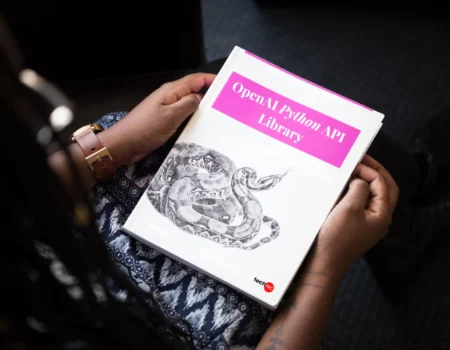A Guide to Using the OpenAI API with Python
OpenAI’s API lets you use advanced AI models without having to build everything from scratch. You don’t need to worry about infrastructure or technical details.
We will explore in the following guide how to set up and use the OpenAI API in Python, including practical examples and tips.
You can also check out: How to Build a Personal AI Assistant with Python.
Why use the OpenAI API?
The OpenAI API gives you access to many powerful AI tools. It can help with text generation, translation, summarization and sentiment analysis. These are great for building chatbots, automating content creation or analyzing large datasets.
With the OpenAI models you can build applications that were previously impossible to build on your own.
Setting Up Your OpenAI Account and API Key
Before jumping to code, set up your OpenAI account and obtain an API key:
- Visit OpenAI’s website and sign up for an account.
- Go to the “API Keys” section in your dashboard.
- Generate a new API key and copy it securely.
This key authenticates your requests, so store it safely. Avoid hardcoding it into your scripts – use environment variables instead.
Different OpenAI Models
OpenAI offers different models. Some of the popular ones:
- GPT Models: For text generation, question answering, and chatbot development. Examples include
gpt-4oandgpt-3.5-turbo. - DALL·E: Generate or edit images based on textual descriptions.
- Whisper: Speech-to-text transcription and translation.
- Embeddings: Text to vector representations for similarity searches and clustering.
Choose the model that aligns with your project’s requirements.
Let’s understand it with hands-on examples with the OpenAI Python API.
Installing the OpenAI Python Library
Install the OpenAI SDK using pip:
pip install openaiOnce installed, import the library into your Python script:
import openai
openai.api_key = "your-api-key"Replace "your-api-key" with your actual API key.
Text Generation
Generate text using the Completion.create method. For example:
response = openai.Completion.create(
model="text-davinci-003",
prompt="Write a one-sentence bedtime story about a unicorn.",
max_tokens=50
)
print(response.choices[0].text.strip())This generates a short story based on the prompt.
Language Translation
Translate text from one language to another:
response = openai.Completion.create(
model="text-davinci-003",
prompt="Translate 'Hello, how are you?' into Spanish.",
max_tokens=50
)
print(response.choices[0].text.strip())The API returns the translated text.
Sentiment Analysis
Perform sentiment analysis on a piece of text:
response = openai.Completion.create(
model="text-davinci-003",
prompt="Sentiment analysis: I love ice cream!",
max_tokens=1
)
print(response.choices[0].text.strip())The output indicates whether the sentiment is positive or negative.
Question Answering
Answer questions based on context:
response = openai.Completion.create(
model="text-davinci-003",
prompt="Context: Albert Einstein was born in Germany.\nQuestion: Where was Albert Einstein born?",
max_tokens=10
)
print(response.choices[0].text.strip())The API extracts answers directly from the provided context.
Summarization
Summarize long pieces of text:
response = openai.Completion.create(
model="text-davinci-003",
prompt="Summarize: Whisper is an ASR system trained on 680,000 hours of data.",
max_tokens=50
)
print(response.choices[0].text.strip())The model condenses the input into a concise summary.
Code Generation
Generate code from natural language descriptions:
response = openai.Completion.create(
model="text-davinci-003",
prompt="Create a Python script to sort a list of numbers in ascending order.",
max_tokens=100
)
print(response.choices[0].text.strip())The API provides functional code snippets.
Building Chatbots
Build conversational agents with ease:
response = openai.Completion.create(
model="gpt-3.5-turbo",
prompt="You are a customer service representative.\nUser: Hi, I have a problem with my account.",
max_tokens=50
)
print(response.choices[0].text.strip())This creates a simple yet effective chatbot response.
Best Practices for Using the OpenAI Python API
To make the best of the OpenAI API, follow these guidelines:
- Optimize Token Usage : Limit
max_tokensto reduce costs and improve performance. - Refine Prompts : Creaet clear and concise prompts to get better results.
- Handle Errors Gracefully : Use try-except blocks to manage exceptions.
- Secure Your API Key : Store your key in environment variables or secure vaults.
- Follow Ethical Guidelines : Avoid using the API for harmful purposes or spreading misinformation.
Advanced Features and Tools
Also, explore advanced features like streaming responses for real-time applications:
stream = openai.Completion.create(
model="gpt-4o",
prompt="Say 'double bubble bath' ten times fast.",
stream=True
)
for chunk in stream:
print(chunk.choices[0].text.strip(), end="", flush=True)Streaming enables dynamic interactions with users. Additionally, integrate tools like web search and file search for enhanced functionality.
Your Next Moves?
The OpenAI Python API lets you easily integrate advanced AI models into your projects. To get started, follow the steps here and begin using the models right away. Experiment with different models, tweak your prompts, and keep an eye on new updates from OpenAI.
Start with small tasks, iterate based on what you learn, and use the API to build real-world solutions.
For more details, check out the OpenAI API Documentation.
Happy Coding!







No Comment! Be the first one.